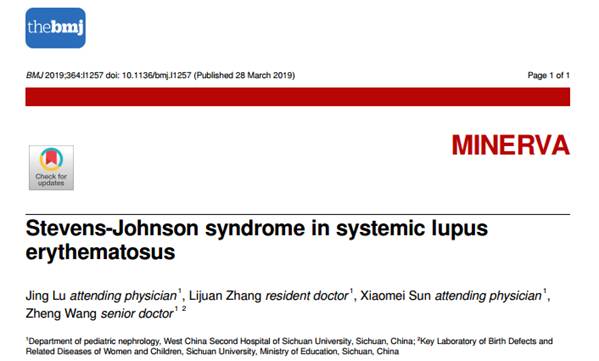Professor Zheng Wang’s team of pediatric nephrology at West China Second University Hospital has recently published a clinical case report titled "Stevens- Johnson Syndrome in Systemic Lupus Erythematosus" in the BMJ, an international famous journal. Jing Lu, chief physician, is the first author of the paper; and Professor Zheng Wang is the corresponding author.

It is well known that Stevens-Johnson syndrome ( SJS ) is mainly related to drug exposure. According to the literature, there are also causes such as herpes simplex virus and mycoplasma infection. In rare cases, it can also result from autoimmune diseases themselves. And infection and autoimmune diseases account for about 20% of Stevens-Johnson syndrome cases. In a large prospective study of SJS and toxic epidermal necrolysis ( TEN ), autoimmune diseases accounted for 4-8% of the reported cases.
Being first proposed over 50 years ago, Rowell syndrome is a group of syndromes with specific skin lesions and potential disease serological antibodies. Now systemic lupus erythematosus and similar diseases have also been reported. some have specific serological abnormalities ( consistent with the diagnosis of Rowell syndrome ), while others do not have specific serological abnormalities. According to Gilliam and Sontheimer's classification of lupus related lesions, Rowell syndrome is a special subtype of SLE with non-specific histopathological skin lesions. This is a syndrome with specific serological changes in patients with lupus erythematosus that has nothing to do with common inducements ( such as drugs or infections ), which may be related to the special immune status of patients with lupus erythematosus. Ample evidence has pointed to drug exposure ( such as antiepileptic drugs, antibiotics, etc.) as the cause of Stevens-Johnson ( SJS ) / toxic epidermal necrolysis ( TEN ), which is a life threatening disease. However, there is only limited awareness of the secondary causes such as infection ( herpes simplex virus, mycoplasma, etc.) and autoimmune diseases. In this case, the young patient has finally recovered after being treated with hormone, immunosuppressive agent, plasma exchange and other conventional therapies.
Article link: http://doi: 10.1136/bmj.l1257
About the journal: Being one of the four leading medical journals in the world, the BMJ’s latest impact factor is 27.604. With a history of 160 years, this journal has rich cultural accumulation and a unique style. It is the most comprehensive of all comprehensive medical journals.
